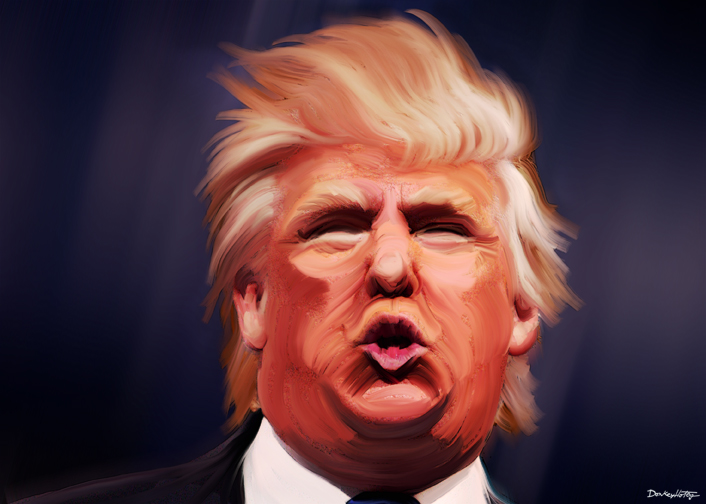By Nycole da Cunha
The rise of the right-wing movement globally is becoming an undeniable reality. Across the world, we see far-right ideologies slowly dominating the room. With the increasing use of social media, hate speech opposing social justice initiatives is being disseminated daily, this shift is often labeled as “post-woke” or “anti-woke”, signaling a backlash against progressive movements. This reactionary shift marks a regressive turn in societal discourse, intensifying existing tensions.
The election of world leaders is a clear reflection of this ongoing transformation. The most prominent example is the political trajectory of the United States, where Donald Trump — the newly elected U.S president, despite being convicted of 34 felonies — has played a significant role in shaping the contemporary conservative wave. Throughout his presidency, Trump engaged in numerous actions that directly attacked human rights. His administration implemented mass deportation operations targeting immigrants, particularly Latinos and Arabs. He also enacted a series of executive orders aimed at restricting transgender rights and dismantled Diversity, Equity, and Inclusion (DEI) initiatives. His political stance, rooted in racism, prejudice, and exclusion, illustrates the broader agenda of this new conservative movement.
Art and Politics
It’s important to note that art and politics are intrinsically linked. Art is a powerful medium capable of influencing perceptions, shaping narratives, and challenging established power structures. It can serve as a form of resistance, a means of reporting social injustices, or, conversely, as a tool for reinforcing ideological agendas.
With today’s technology, visual arts can be disseminated globally, making them a crucial force in shaping political consciousness. Images, paintings, films, and other artistic expressions have the power to tell us something important about the world or make us see it in a new light, they can offer critical insights into social realities or even redefine them. Art has the power to provoke emotions and mold public opinion, demonstrating its essential role in shaping narratives and political discourses. The rapid evolution of technology has amplified the reach and impact of visual art. While the most widely circulated news and images often originate from the Western world, this dynamic is particularly significant for marginalized communities. As Roland Bleiker (2018) points out in Visual Global Politics “we live in an age of the democratic image but also in an age of the fascist image”. In that way, it grants them a voice, digital platforms have created opportunities for these communities to share their realities and engage in global discussions. However, it also “paves the way for violent encounters”. This duality underscores the power of visual media: while it can serve as a platform for resistance and representation, it can also be manipulated as a weapon for oppression.
The Impact of the New Conservative Wave on the Art World
Therefore, given the increasing influence of far-right ideologies, it is inevitable that the new conservative wave will have its impacts in the art world and artistic expression will face challenges. Historically, authoritarian and conservative regimes have often sought to suppress dissenting artistic voices, perceiving them as threats to their authority. During World War II, when the Nazi party assumed control in 1933, the regime swiftly initiated a campaign against modern art, which they labeled as “degenerate art”. They wanted not only to control politics but also the culture. In 1937, they had confiscated over 20,000 artworks, controlling what could or could not be displayed or sold — or even produced. They saw how the arts were valuable in shaping society. Through these actions, Hitler manipulated and restricted artistic expression to reinforce a supposed racial hierarchy, dehumanizing artists who did not conform to the Nazi narrative.
This pattern has repeated in various conservative governments around the world. The current conservative wave follows a similar trajectory, with attempts to defund and delegitimize institutions that promote diversity and inclusion. In Freemuse’s 2022 report, 1,251 violations of artistic freedom were documented across 103 countries in 202, including the killing of 39 artists, the detention of 253, the prosecution of 133, and 287 instances of censorship. The report highlights a significant increase in threats to artistic freedom, this rise that can be attributed to factors such as reactionary laws and growing conservatism. Given this trend, it is no surprise that Trump chose to close DEI programs in the United States.
The erosion of DEI initiatives highlights the broader struggle against artistic and cultural censorship. These policies were designed to ensure diverse representation and equitable opportunities within the arts, academia, and public institutions. Their dismantling reflects a deeper resistance to progressive change and a desire to maintain existing power hierarchies. The suppression of DEI initiatives can pose significant challenges to the art world. Without institutional support, artists from marginalized communities may struggle to gain visibility, funding, or opportunities to share their work. Additionally, the conservative backlash against critical artistic expressions fosters an environment where censorship and self-censorship become prevalent.
The intersection of conservatism and art is a battleground where ideological conflicts unfold. In the face of these challenges, the role of art as a tool for resistance and social commentary remains vital. As history has shown, art has the power to shape political landscapes, challenge oppressive structures, and inspire movements for justice and equality. The future of artistic expression will depend on the collective efforts to safeguard creative freedom against the tides of conservative suppression.
(image by DonkeyHotey)

